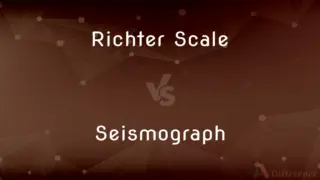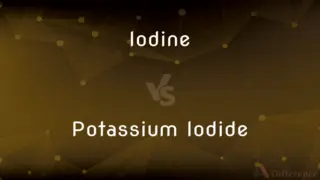Integer Number vs. Whole Number — What's the Difference?
Edited by Tayyaba Rehman — By Fiza Rafique — Published on November 30, 2023
Integer Numbers include positive, negative numbers, and zero (e.g., -2, -1, 0, 1, 2). Whole Numbers are non-negative integers (e.g., 0, 1, 2).

Difference Between Integer Number and Whole Number
Table of Contents
ADVERTISEMENT
Key Differences
Integer Numbers are a broader category in mathematics that encompasses all positive numbers, negative numbers, and zero. They extend indefinitely in both positive and negative directions on the number line.
Whole Numbers, on the other hand, are a subset of the Integer Numbers. They only consist of positive numbers and zero. This means that while every Whole Number is an Integer Number, not every Integer Number is a Whole Number.
Integer Numbers can be visualized on a number line stretching infinitely in both directions. For instance, -3, -2, -1, 0, 1, 2, 3 are all Integer Numbers, showing their inclusivity of negative values.
Whole Numbers begin at zero and continue infinitely in the positive direction. 0, 1, 2, 3, and so on, are all Whole Numbers. They exclude any negative values, differentiating them from Integer Numbers.
Both Integer Numbers and Whole Numbers have their places in mathematics. While Integer Numbers are more comprehensive, including all values from negative infinity to positive infinity, Whole Numbers represent only non-negative values, including zero.
ADVERTISEMENT
Comparison Chart
Inclusivity
Positive, negative, and zero
Only non-negative integers
Example Values
-3, -2, -1, 0, 1, 2, 3
0, 1, 2, 3
Position on Number Line
Extends indefinitely in both directions
Starts at zero and extends indefinitely positive
Negative Numbers
Included
Excluded
Subset Relationship
Encompasses Whole Numbers
A subset of Integer Numbers
Compare with Definitions
Integer Number
Integer Numbers are numbers without fractional parts.
-5 is an Integer Number as it doesn't have a decimal or fraction.
Whole Number
Every Whole Number is an Integer Number, but not vice versa.
4 is both a Whole Number and an Integer Number, but -4 is just an Integer Number.
Integer Number
Integer Numbers include both negative and positive numbers.
-8 and 8 are both Integer Numbers representing opposite values.
Whole Number
Whole Numbers start at zero and continue indefinitely in the positive direction.
0, 5, and 100 are all Whole Numbers as they're non-negative.
Integer Number
Every whole number is an Integer Number.
While 6 is both a Whole Number and an Integer Number, -6 is only an Integer Number.
Whole Number
Whole Numbers are a subset of Integer Numbers.
While 10 is both a Whole Number and an Integer Number, -10 is only an Integer Number.
Integer Number
Integer Numbers can represent values below and above zero.
-3 is an Integer Number below zero, while 3 is above zero.
Whole Number
Whole Numbers are non-negative numbers without fractions.
7 is a Whole Number because it's positive and doesn't have a fraction.
Integer Number
Integer Numbers span from negative infinity to positive infinity.
-1000 and 1000 are both distant Integer Numbers on the number line.
Whole Number
Whole Numbers exclude negative values.
15 is a Whole Number, while -15 isn't.
Common Curiosities
What are Whole Numbers?
Whole Numbers are non-negative integers, starting from zero and going up without limits.
Can an Integer Number be negative?
Yes, Integer Numbers can be negative, positive, or zero.
Is zero considered a Whole Number or an Integer Number?
Zero is considered both a Whole Number and an Integer Number.
What are Integer Numbers?
Integer Numbers include all positive, negative numbers, and zero without fractions.
Is -5 an Integer Number or a Whole Number?
-5 is an Integer Number, but not a Whole Number.
Are all Integer Numbers Whole Numbers?
No, only non-negative Integer Numbers are Whole Numbers.
Are all Whole Numbers Integer Numbers?
Yes, all Whole Numbers are Integer Numbers.
Do Whole Numbers include fractions or decimals?
No, Whole Numbers don't include fractions or decimals.
Can a Whole Number be negative?
No, Whole Numbers are always non-negative.
How do Integer Numbers and Whole Numbers differ?
Integer Numbers include negative, positive, and zero, while Whole Numbers are only non-negative.
Is 5 both an Integer Number and a Whole Number?
Yes, 5 is both an Integer Number and a Whole Number.
Do Integer Numbers include fractions or decimals?
No, Integer Numbers are whole numbers without fractions or decimals.
How are Whole Numbers represented on a number line?
Whole Numbers start at zero and continue indefinitely in the positive direction.
How are Integer Numbers represented on a number line?
Integer Numbers extend indefinitely in both negative and positive directions.
Which set is broader, Integer Numbers or Whole Numbers?
Integer Numbers is a broader set, as it includes Whole Numbers as a subset.
Share Your Discovery

Previous Comparison
Richter Scale vs. Seismograph
Next Comparison
Iodine vs. Potassium IodideAuthor Spotlight
Written by
Fiza RafiqueFiza Rafique is a skilled content writer at AskDifference.com, where she meticulously refines and enhances written pieces. Drawing from her vast editorial expertise, Fiza ensures clarity, accuracy, and precision in every article. Passionate about language, she continually seeks to elevate the quality of content for readers worldwide.
Edited by
Tayyaba RehmanTayyaba Rehman is a distinguished writer, currently serving as a primary contributor to askdifference.com. As a researcher in semantics and etymology, Tayyaba's passion for the complexity of languages and their distinctions has found a perfect home on the platform. Tayyaba delves into the intricacies of language, distinguishing between commonly confused words and phrases, thereby providing clarity for readers worldwide.













































